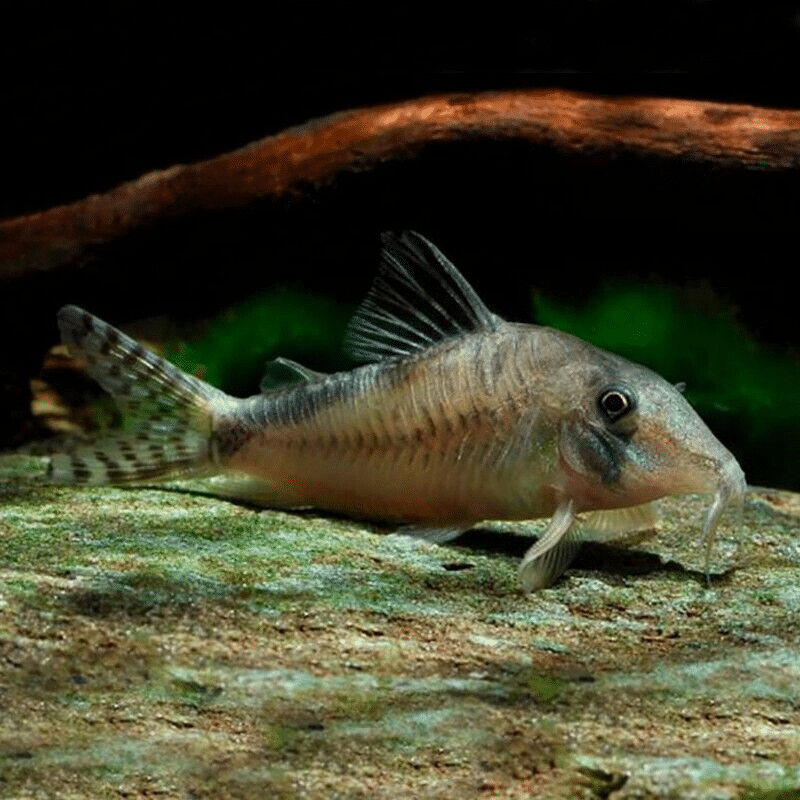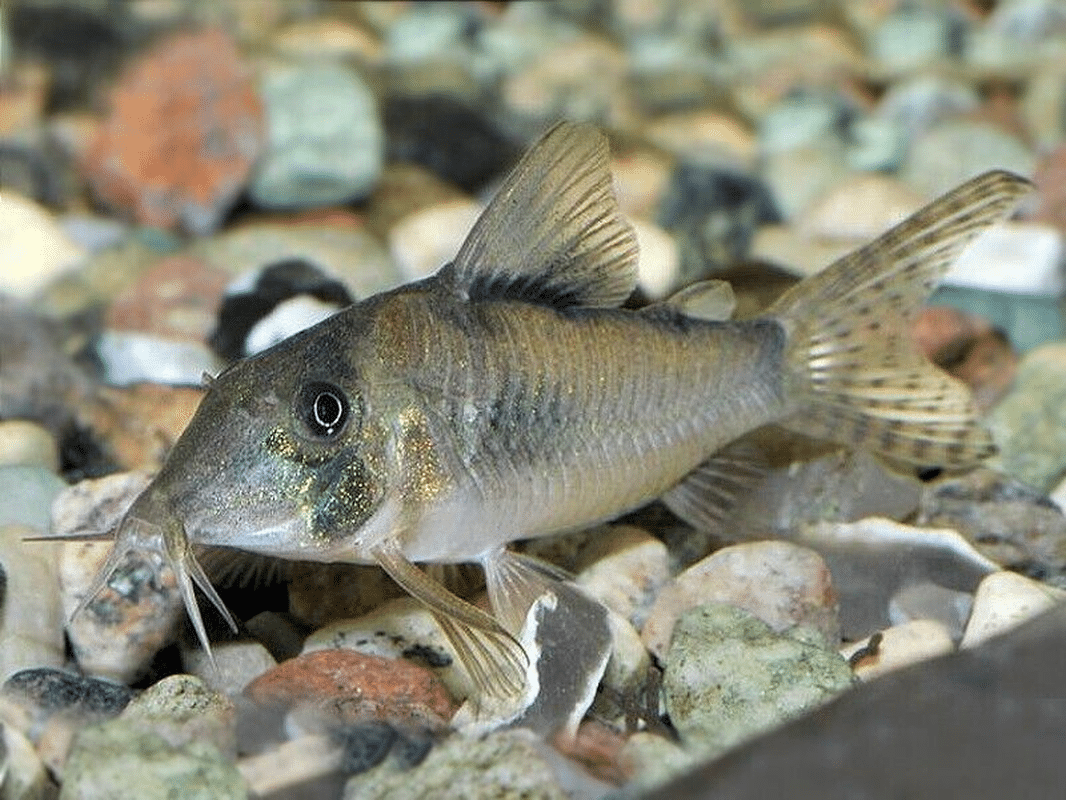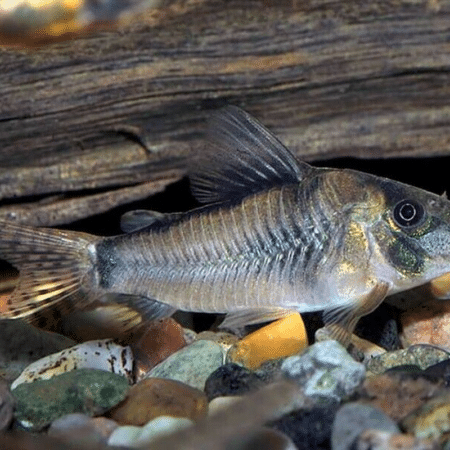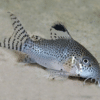Subtotal: £8.71
Olga Cory – Corydoras Simulatus – Masquerade Corydoras – South American Catfish, Bring Vibrant Life to Your Tank, Easy to Care for and Peaceful Community Fish for Any Aquarist
£19.49 Original price was: £19.49.£16.45Current price is: £16.45.
Welcome these beautiful Olga Cory, or Corydoras Simulatus, to your aquarium. Known for their stunning coloration and graceful movements, these peaceful South American catfish thrive in community tanks. Create a vibrant aquatic habitat with these charming companions.
2003 in stock
Species Introduction
The Olga Cory, scientifically known as Corydoras simulatus, is a captivating species of catfish originating from the lush waterways of South America. These delightful aquatic companions are renowned for their peaceful demeanor and vibrant appearance, making them a favored choice among aquarists. In their natural habitat, they inhabit slow-moving streams and rivers, often found in sandy or muddy substrates where they can forage for food. The Olga Cory is particularly notable for its striking coloration, which includes a unique pattern of spots and stripes that mimic the appearance of a masquerade mask, hence the name ‘Masquerade Corydoras’. This species thrives in well-planted environments that replicate their natural setting, providing them with ample hiding spots and foraging opportunities. As a community fish, they are best kept in groups and coexist harmoniously with a variety of other species, making them an excellent addition to any community tank.
Care Requirements Dashboard
✓ Care Level: Easy
Tank Size: Minimum 20 gallons
Water Temperature: 72°F – 78°F (22°C – 26°C)
pH Level: 6.0 – 7.5
Hardness: 2 – 15 dGH
Essential Care Guide for Your Olga Cory – Corydoras Simulatus – Masquerade Corydoras
| Optimal Living Conditions | |
|---|---|
| Water Temperature | 22-28°C (72-82°F) |
| pH Level | 6.0-7.5 |
| Water Hardness | 2-15 dKH |
| Minimum Tank Size | 120L (30 gal) |
| Salinity | Freshwater |
| Care Level | Beginner to Intermediate |
Natural Behavior & Temperament
The Olga Cory is a peaceful and sociable fish, known for its engaging behavior and lively antics. They are bottom-dwellers, often seen foraging through the substrate for food, which includes detritus, small invertebrates, and plant matter. Their natural behavior includes swimming in small schools, which not only provides them with a sense of security but also enhances their social interactions. Observing these fish in a community tank is a delight, as they exhibit playful interactions with their tank mates. They are particularly active during the day, often darting around the tank and exploring every nook and cranny. Their calm demeanor makes them compatible with a wide range of other community fish, contributing to a harmonious aquarium environment.
Tank Setup Guide
✓ Ideal Environment: Planted tanks
Substrate: Fine sand or smooth gravel
Decorations: Rocks, driftwood, live plants
Lighting: Moderate, with shaded areas
Creating an ideal environment for your Olga Cory is essential for their well-being. A well-planted tank with fine sand or smooth gravel substrate is recommended, as it allows them to forage naturally without damaging their delicate barbels. Incorporating rocks, driftwood, and live plants not only enhances the aesthetic appeal of the aquarium but also provides hiding spots and territories for these fish. Moderate lighting is preferable, with shaded areas to mimic their natural habitat. This setup will encourage natural behaviors and promote a thriving community of aquatic companions.
Water Quality Management
✓ Water Parameters: Stable conditions
pH Level: 6.0 – 7.5
Temperature: 72°F – 78°F (22°C – 26°C)
Hardness: 2 – 15 dGH
Maintaining optimal water quality is crucial for the health of your Olga Cory. Regular testing of pH levels, temperature, and hardness will help ensure a stable environment. The pH should be kept between 6.0 and 7.5, with a temperature range of 72°F to 78°F. Additionally, hardness levels should be monitored to remain between 2 and 15 dGH. Performing regular water changes and using a quality filtration system will aid in keeping the water clean and clear, reducing stress on your fish and promoting their overall health.
Feeding & Nutrition
✓ Diet: Omnivorous
Primary Foods: Sinking pellets, flakes, frozen foods
Feeding Schedule: 2-3 times daily
Special Considerations: Variety is key
The Olga Cory is an omnivorous fish that thrives on a varied diet. Providing a mix of sinking pellets, high-quality flakes, and occasional frozen or live foods will ensure they receive the nutrition they need. It is important to feed them 2-3 times daily, offering only what they can consume within a few minutes to prevent overfeeding and maintain water quality. Incorporating a variety of food types not only promotes their health but also enhances their coloration and vitality. Observing their feeding behavior can be quite entertaining, as they eagerly scavenge through the substrate for morsels.
Compatibility Guide
✓ Ideal Tank Mates: Community-friendly
Compatible Species: Tetras, Rasboras, Guppies, Danios
Avoid: Aggressive or large fish
The Olga Cory is a peaceful community fish that thrives in a well-balanced aquarium. They are compatible with a variety of species, including tetras, rasboras, guppies, and danios. When selecting tank mates, it is essential to avoid aggressive or larger fish that may pose a threat to their well-being. Keeping them in groups of at least six will help them feel secure and promote their natural social behavior. A harmonious community tank will not only enhance the beauty of your aquarium but also provide a thriving environment for all inhabitants.
Health & Wellness
✓ Common Issues: Preventative care
Signs of Stress: Faded colors, hiding, lethargy
Prevention: Regular water changes, proper diet
Maintaining the health and wellness of your Olga Cory is essential for their longevity. Common issues include stress, which can manifest as faded colors, excessive hiding, or lethargy. To prevent these problems, it is crucial to provide a stable environment with regular water changes and a proper diet. Monitoring their behavior and appearance will help you identify any potential health concerns early. If any signs of illness or stress are observed, it is important to investigate the underlying causes and take appropriate action to ensure the well-being of your fish friends.
Breeding Information
✓ Breeding: Possible in community tanks
Spawning Conditions: Clean water, gentle current, suitable substrate
Fry Care: Small food, high water quality
Breeding the Olga Cory can be a rewarding experience for aquarists. They are known to spawn in groups, typically during water changes or when conditions are optimal. To encourage breeding, ensure that the water is clean, with a gentle current and suitable substrate for the eggs. Once the eggs are laid, they should be removed to prevent them from being eaten by adult fish. Fry care is crucial, as they require small food and pristine water quality to thrive. Monitoring the growth of the fry and providing appropriate nutrition will help ensure their successful development into healthy juvenile fish.
Acclimation Process
✓ Acclimation: Gradual introduction
Method: Drip acclimation recommended
Duration: 1-2 hours
When introducing your Olga Cory to a new tank, a gradual acclimation process is vital to reduce stress and ensure a smooth transition. The drip acclimation method is highly recommended, allowing the fish to adapt slowly to the new water parameters. This process typically takes 1-2 hours, during which the fish can adjust to the temperature and chemistry of the new environment. After acclimation, gently release them into the tank, ensuring they have ample hiding spots to feel secure in their new home.
Long-term Care
✓ Lifespan: 5-10 years
Growth Expectations: Up to 3 inches
Regular Maintenance: Essential for health
With proper care, Olga Corys can live for 5 to 10 years, making them a long-term commitment for any aquarist. They typically grow to a size of about 3 inches, and regular maintenance is essential to ensure their health and longevity. This includes monitoring water quality, performing routine water changes, and providing a balanced diet. Regular observation of their behavior and appearance will help you catch any potential issues early, allowing for timely intervention and care.
Natural Habitat Recreation
✓ Biotope Setup: Mimic natural conditions
Substrate: Fine sand, leaf litter
Plants: Anubias, Java fern, floating plants
Creating a biotope that mimics the natural habitat of the Olga Cory can enhance their well-being and promote natural behaviors. Using fine sand as a substrate, along with leaf litter, will replicate their natural foraging environment. Incorporating live plants such as Anubias and Java fern will provide hiding spots and contribute to water quality. Floating plants can also offer shaded areas, creating a comfortable environment for your fish friends. This setup not only benefits the Olga Cory but also adds beauty and diversity to your aquarium.
Seasonal Care Adjustments
✓ Seasonal Changes: Monitor conditions
Temperature Adjustments: Maintain stability
Lighting: Adjust for seasonal variations
As seasons change, it’s important to monitor and adjust the conditions in your aquarium to ensure the comfort of your Olga Cory. Maintaining a stable temperature is crucial, as fluctuations can cause stress. Adjusting lighting to mimic natural day lengths can also benefit plant growth and fish behavior. Regular checks on water parameters will help you catch any changes that may occur with seasonal shifts, ensuring a healthy and thriving environment for your aquatic companions.
Expert Tips
✓ Professional Advice: Enhance your setup
Tip 1: Use a sponge filter for gentle water flow
Tip 2: Incorporate driftwood for natural hiding spots
To create the best environment for your Olga Cory, consider using a sponge filter, which provides gentle water flow and helps maintain water quality without disturbing the substrate. Incorporating driftwood can also enhance their habitat, providing natural hiding spots and promoting their comfort. Regularly observing their behavior and interactions with tank mates will give you insights into their needs and preferences, allowing you to adjust their environment accordingly.
Troubleshooting
✓ Common Problems: Quick solutions
Issue: Cloudy water
Solution: Regular water changes and filtration maintenance
If you encounter issues such as cloudy water, it is essential to address the problem promptly. Regular water changes and maintenance of your filtration system will help restore clarity and improve water quality. Additionally, ensure that you are not overfeeding your fish, as excess food can contribute to water quality issues. Observing your fish for any signs of stress or illness will help you identify problems early, allowing for timely interventions.
Scientific Background
✓ Taxonomy: Understanding the species
Family: Callichthyidae
Order: Siluriformes
Conservation Status: Least Concern
The Olga Cory belongs to the family Callichthyidae and the order Siluriformes, which encompasses a diverse group of catfish. This species is classified as ‘Least Concern’ in terms of conservation status, indicating that it is not currently at risk of extinction. Understanding the scientific background of your fish can enhance your appreciation for their role in the aquatic ecosystem and highlight the importance of responsible aquarium practices.
Advanced Care Techniques
✓ Expert-Level Husbandry: Enhance fish health
Technique 1: Use a quarantine tank for new arrivals
Technique 2: Implement a varied diet for optimal health
For those looking to enhance their care for Olga Corys, consider using a quarantine tank for new arrivals to prevent the introduction of diseases into your main aquarium. This practice allows you to monitor the health of new fish before introducing them to your established community. Additionally, implementing a varied diet that includes high-quality pellets, flakes, and occasional live or frozen foods will promote optimal health and vibrant coloration in your fish friends. Regularly assessing their environment and dietary needs will ensure a thriving community of aquatic companions.
Water Quality Parameters
Optimal Range
24-27°C
6.5-7.5
0 ppm
Caution Zone
22-24°C or 27-29°C
6.0-6.5 or 7.5-8.0
0.25-0.5 ppm
Danger Zone
<22°C or >29°C
<6.0 or >8.0
>0.5 ppm
Monitoring Tip: Test water parameters weekly and perform regular water changes to maintain optimal conditions for your aquatic friends!
Frequently Asked Questions
Q: What tank size is required for the Olga Cory?
For the Olga Cory (Corydoras simulatus), a minimum tank size of 60 litres (15 gallons) is recommended. This size provides ample swimming space and allows for a small group of these social fish to thrive. It is advisable to keep them in groups of at least five or six individuals, as they are naturally social creatures. A larger tank not only enhances their comfort but also helps maintain stable water parameters, which is crucial for their health.
✓ Expert Tip
Ensure your tank has hiding spots and plants to mimic their natural habitat, which helps reduce stress.
Q: What water parameters do Olga Corys require?
Olga Corys thrive in soft, slightly acidic to neutral water conditions. Aim for a pH level between 6.0 and 7.5, with a hardness of 2-15 dGH. The ideal temperature range is 22-28°C (72-82°F). Regular water changes of 20-30% weekly will help maintain these parameters and improve overall water quality. Using a good-quality water conditioner can also aid in removing harmful toxins, making the water safe for your aquatic companions.
✓ Expert Tip
Consider using a gentle filter to avoid strong currents, which can stress these bottom-dwelling fish.
Q: How often should I feed Olga Corys?
Feed your Olga Corys small portions of high-quality sinking pellets, flakes, or wafers twice daily. They are omnivores and will benefit from a varied diet that includes frozen or live foods such as bloodworms or brine shrimp occasionally. Ensure that all food is consumed within a few minutes to prevent water quality issues. Overfeeding can lead to health problems, so it is crucial to monitor their intake closely.
✓ Expert Tip
Introduce a variety of food types to enhance their colouration and overall health.
Q: What are the best tank mates for Olga Corys?
Olga Corys are peaceful fish and generally do well in community tanks. Suitable tank mates include small to medium-sized fish such as tetras, guppies, and rasboras. It is essential to avoid larger or aggressive species that might bully them. Additionally, ensure that any tank mates share similar water parameters to maintain a harmonious environment. A well-planned community tank enhances the wellbeing of all inhabitants.
✓ Expert Tip
Always introduce new fish gradually to reduce stress and aggression.
Q: How do I properly acclimatise Olga Corys to my aquarium?
To acclimatise your Olga Corys, float the sealed bag containing the fish in your aquarium for about 15-20 minutes to equalise the temperature. After this, gradually mix small amounts of your aquarium water into the bag over the course of an hour. This process helps the fish adjust to the new water parameters. Once acclimatised, gently release the fish into the tank using a net to avoid introducing bag water.
✓ Expert Tip
Avoid adding too many fish at once to minimise stress and ensure a stable environment.
Q: What are the signs of healthy Olga Corys?
Healthy Olga Corys exhibit vibrant colouration, clear eyes, and active behaviour. They should swim confidently and display social interaction with tank mates. Observe their eating habits; a healthy fish will eagerly consume food. Additionally, check for any signs of distress, such as erratic swimming, clamped fins, or visible lesions. Regular monitoring is essential to catch any health issues early, ensuring a long and happy life for your aquatic companions.
✓ Expert Tip
Maintain stable water conditions to enhance their health and vitality.
Q: How do I successfully breed Olga Corys?
Breeding Olga Corys can be a rewarding endeavour. To encourage spawning, maintain a separate breeding tank with soft, slightly acidic water. Provide spawning sites like flat stones or plants. Once the female lays eggs, remove the adults to prevent them from eating the eggs. The eggs typically hatch within 3-5 days, and newly hatched fry should be fed with infusoria or finely crushed flake food. Ensure optimal water quality and temperature to support their growth.
✓ Expert Tip
Keep the breeding environment calm and stable to encourage successful breeding.
Q: What substrate is most suitable for Olga Corys?
Olga Corys prefer a soft substrate, such as sand or fine gravel, which allows them to forage comfortably. They are known to sift through the substrate for food, so a smooth substrate reduces the risk of injury. Additionally, providing hiding spots and plants will create a more natural environment, enhancing their overall wellbeing. Avoid sharp or coarse gravel, as it can harm their delicate barbels.
✓ Expert Tip
Incorporate natural decorations to create a stimulating environment that mimics their habitat.
Q: What behavioural patterns should I expect from Olga Corys?
Olga Corys are known for their playful and social behaviour. They often swim in groups, darting around the tank and exploring the substrate. These fish enjoy foraging, sifting through the sand for food, and are generally peaceful with other species. They may exhibit occasional playful chasing, especially during feeding times. Observing their social interactions can be quite delightful, as they communicate through subtle body movements and postures.
✓ Expert Tip
Provide plenty of hiding places to allow them to feel secure and reduce stress.
Q: How can I prevent common diseases in Olga Corys?
Preventing diseases in Olga Corys primarily involves maintaining high water quality and stable parameters. Regular water changes, proper filtration, and avoiding overfeeding are essential practices. Additionally, quarantine new arrivals before introducing them to your main tank to prevent potential outbreaks. Observing your fish for signs of stress or illness will allow you to intervene early. A healthy diet rich in nutrients also supports their immune system, making them less susceptible to diseases.
✓ Expert Tip
Consider adding aquarium salt at recommended levels to promote gill health and reduce stress.
Q: What lighting conditions do Olga Corys prefer?
Olga Corys prefer subdued lighting that mimics their natural habitat, which consists of shaded areas in rivers and streams. Using a combination of ambient and soft lighting can create a comfortable environment for them. Floating plants or decorations can help diffuse bright light, making the tank feel more secure. Avoid intense lighting, as it can stress these fish and encourage algae growth, which can impact water quality.
✓ Expert Tip
Consider a light timer to maintain consistent lighting periods, promoting a healthy day-night cycle.
Q: How do I recognise stress in Olga Corys?
Recognising stress in Olga Corys can be vital for their wellbeing. Signs of stress include erratic swimming, hiding excessively, clamped fins, and loss of appetite. They may also display colour fading or increased aggression towards tank mates. Maintaining stable water conditions, providing adequate hiding spots, and ensuring a compatible community can help reduce stress. Regular observation of their behaviour will enable you to identify any changes promptly.
✓ Expert Tip
If stress is observed, assess the tank environment and any recent changes that may have affected their behaviour.
Q: What natural habitat conditions should I replicate for Olga Corys?
To replicate the natural habitat of Olga Corys, focus on creating a soft substrate, plenty of hiding spots, and subdued lighting. Their natural environment consists of slow-moving rivers with sandy bottoms and dense vegetation. Incorporating driftwood, rocks, and live plants will provide natural shelter and foraging opportunities. Additionally, maintaining slightly acidic water with low hardness will help recreate their habitat, promoting their health and comfort.
✓ Expert Tip
Using natural elements in your aquascaping can also enhance the aesthetic appeal of your aquarium.




















Emily Carter (verified owner) –
I recently added the Olga Cory – Corydoras Simulatus to my aquarium, and I couldn’t be happier! These Masquerade Corydoras are not only stunning with their unique patterns, but they’re also incredibly friendly. After about two weeks in my tank, they’ve settled in beautifully, swimming around playfully and foraging for food. I love how they scavenge the substrate together, which keeps my aquarium lively.
I’ve kept several types of catfish, but I find these corydoras to have such a charming personality compared to others. They tend to be more social and less skittish than some of my previous choices. Shipping was quick, and they arrived in perfect condition, which is so important for their welfare. Just a heads up, they do prefer to be in groups, so I recommend getting at least a few to really see their natural behavior shine.
If you’re looking for a peaceful and engaging addition to your aquarium fish collection, I wholeheartedly recommend these Corydoras. They’ve brought so much joy to my tank!
Emily Carter (verified owner) –
I recently added the Olga Cory – Corydoras Simulatus to my aquarium, and I couldn’t be happier! These little catfish have brought such vibrant life to my tank. After just two weeks, I noticed them darting around playfully and exploring every nook and cranny. Their peaceful nature makes them the perfect companions for my other community fish, and I love watching them interact.
What I appreciate most is how easy they are to care for. They thrive in a well-planted tank with gentle filtration, which I set up based on the helpful care instructions included with my order. I also love how their beautiful patterns add a unique aesthetic to my setup, way more engaging than other corydoras I’ve kept in the past.
One minor concern was that they were a bit shy at first, often hiding during the day, but now they’re much more active, especially during feeding time. If you’re looking for a peaceful and charming addition to your aquarium, I highly recommend the Olga Cory. They’re perfect for both beginners and seasoned aquarists alike. I will definitely be purchasing more in the future!